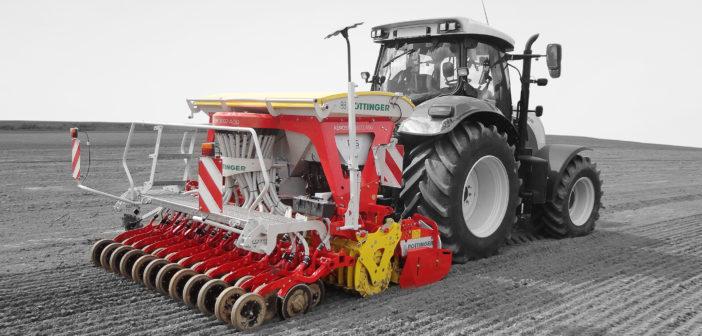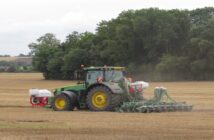Heavy rain causes major problems, especially with maize crops. Pöttinger offers the solution with the multiple award-winning Aerosem mulch seed drill for planting a companion crop with maize.
Heavy rain and high volumes of water can frequently lead to environmental and socio-political issues: from nitrate leaching and pesticides entering surface water and causing fish to die, through to landslides and desolation as a result of soil being washed away, erosion, loss of humus and yield depletion.
When large, heavy rain drops impact the soil with maximum force, the soil breaks up into its smallest components. This, combined with large volumes of water flowing across the surface, causes erosion to take over. On slopes the problem is even more critical. Surface ponding and soil erosion cause unnecessary costs from a socio-political standpoint, with surface soil or pools of water accumulating in private gardens, or loss in value of arable fields as a result of humus erosion.
Targeting a reduction in erosion by using a companion crop
A companion crop can make a significant contribution to reducing erosion. In a series of tests performed by Pöttinger in cooperation with UCL university in Belgium, they perfected the process for achieving the optimum ratio between the companion crop and primary crop seed rates for a perfect balance between reducing soil erosion and increasing yield.
The right application of the companion crop plays a decisive role: it is essential that the companion crop is drilled at the same time as the maize in a single pass. In addition, the companion crop must be placed using purpose-specific shares so that germination starts as soon as possible. This process is necessary to ensure rapid development of the companion crop. Only then can erosion protection take effect. Broadcasting would leave the companion crop on the surface, delaying germination so that cover is not provided until later. By the time the first phytosanitary measures are applied to the maize in its six to eight leaf stage, the companion crop has become well established and is in a position to withstand such measures. Its rate of growth will be slowed down slightly, but it will not be destroyed. The companion crop loses height compared to the maize so that the maize plants can continue to develop unrestricted. Following the row integration of the maize plants, the companion crop is growing at its full rate again and the available light is sufficient to ensure that the companion crop covers and protects the soil.
AEROSEM with PCS for a companion crop
With PCS (Precision Combi Seeding), the latest development on the AEROSEM, Pöttinger leads the way in pneumatic seed drills.
With the new development of the AEROSEM pneumatic seed drill, Pöttinger has come up with a unique capability: integrating precision seed drill technology into a standard pneumatic seed drill. The advantages of both worlds have been united in one machine that is especially suitable for drilling maize. The drill is fitted with up to ten individual seed elements for a row spacing of 37.5 cm or 75 cm (and 12.5 cm on the AEROSEM ADD). Application-specific fertilization is also built into this machine: using the standard metering system with a distributor head add-on, fertilizer can be applied between the seed rows. Of even greater interest here is the grass companion crop option, combined with precision seed drilling, to provide optimum erosion protection. Another step into the future!
The technical features in detail
The seed hopper is divided into two segments: one for precision seed drilling (there are no individual tanks for each row) and one for fertilizer or the companion crop. Switching between normal drilling and precision drilling is performed by moving the partition between the two segments. A seed level sensor is fitted on both sides.
Everything considered, if a companion crop is planted correctly it is a sustainable method that provides clear economic advantages.




